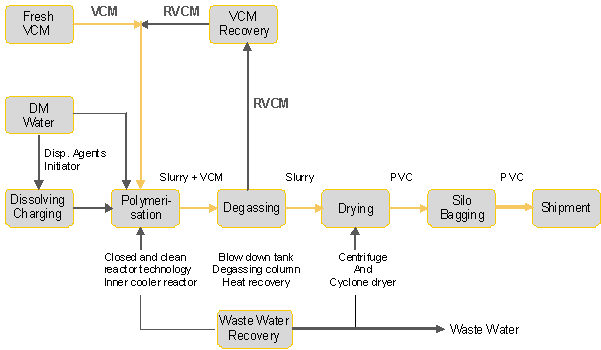SUSPENSION-PVC Process and HIGH PERFORMANCE REACTOR
The SUSPENSION process for manufacturing polyvinyl chloride is the most important method to produce a variety of general purpose and highly sophisticated grades of PVC. The process was invented in 1935 and first patented by WACKER CHEMIE GmbH, one of the former parent companies of VINNOLIT. Continuous developments had been done in recipes, product quality and technology. Due to this long experience and continuous improvements, VINNOLIT can offer a modern and highly economic process for the production of S-PVC worldwide.
The polymerization reaction is carried out batch-wise in stirred reactors of the „High Performance Reactor“ type, in sizes up to 160 m3 each. Number and size of the reactors is depending on capacity and product mix. The unique design of this type of reactor allows a very efficient heat-removal out of the reactor, so high productivity rates can be achieved without using of reflux condenser technology or chilled water.

The adventages of the Vinnolit process can be summarized as follows:
- Low consumption of monomers, demin. water, chemicals and auxiliary materials
- Low energy consumption
- Results in low production cost
- Especially, the utilisation of hot water generated in the VCM plant for heating of the PVC drier yields very low energy consumption in the PVC plant
Low consumption figures:
- Consumption per 1,000 kg of PVC powder at the production plant including VCM recovery
- Vinyl chloride 1,001 kg
- Demineralised water 1.4 kg
- Chemicals 2.5 kg
- Steam 700 kg
- Steam 700 kg
- Without waste water recovery 2.3 m3
- Integration with VCM Combined figure for VCM and PVC plant: 435 kg
The Vinnolit high-performance reactor for suspension PVC
The Vinnolit High Performance Reactors with 115 m3 reactor volume are operated at Vinnolit’s production site in Knapsack, near Cologne, Germany.
Optimized reactor design, the use of high effective anti fouling agents and modern recipes make it possible to operate the reactors for more than one year without opening and high-pressure cleaning procedure. Simultaneous charging procedure of hot water and VCM reduces charging time and eliminates additional heat up in the process. The variable process allows the production of PVC grades with K-values between 57 and 75. Degassing and drying of the PVC slurry will be done in the continuous degassing and drying process. The low VCM content of residual VCM in the PVC slurry and in the final product is achieved with the high efficient, proprietary VINNOLIT degassing column. To avoid stress and thermal degradation of the product, stripping of the remaining VCM is carried out under moderate conditions with steam.
The advantages of the Vinnolit process can be summarized as follows:
- High output of up to 600 mt/m3/year
- High quality of product grades
- Large reactor volumes of up to 160 m3
- Large heat transfer area and high heat transition coefficient
- Very simple and save operation
- Low operation costs
